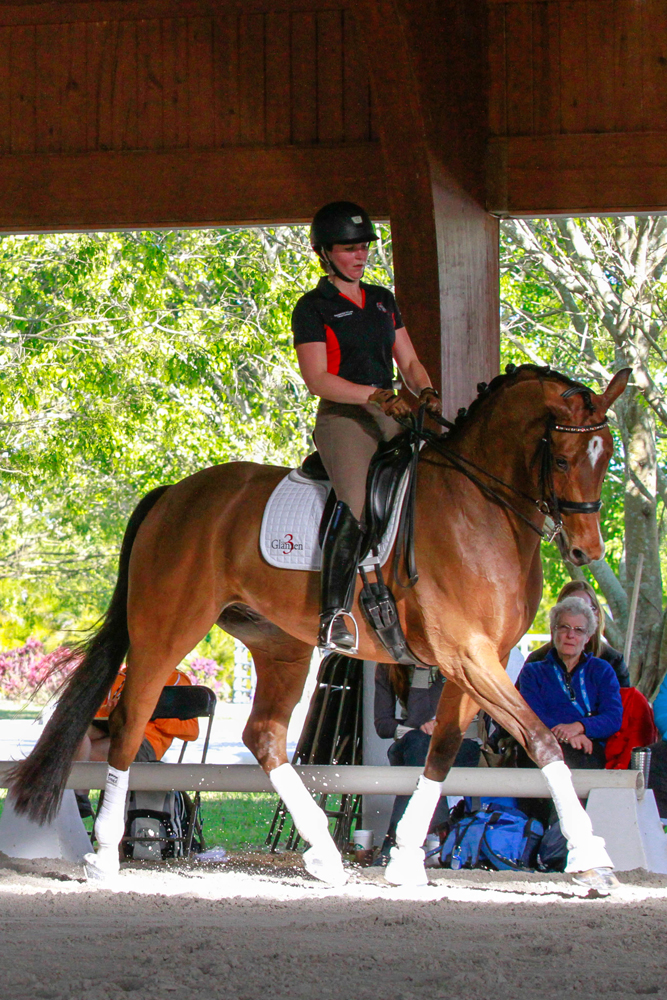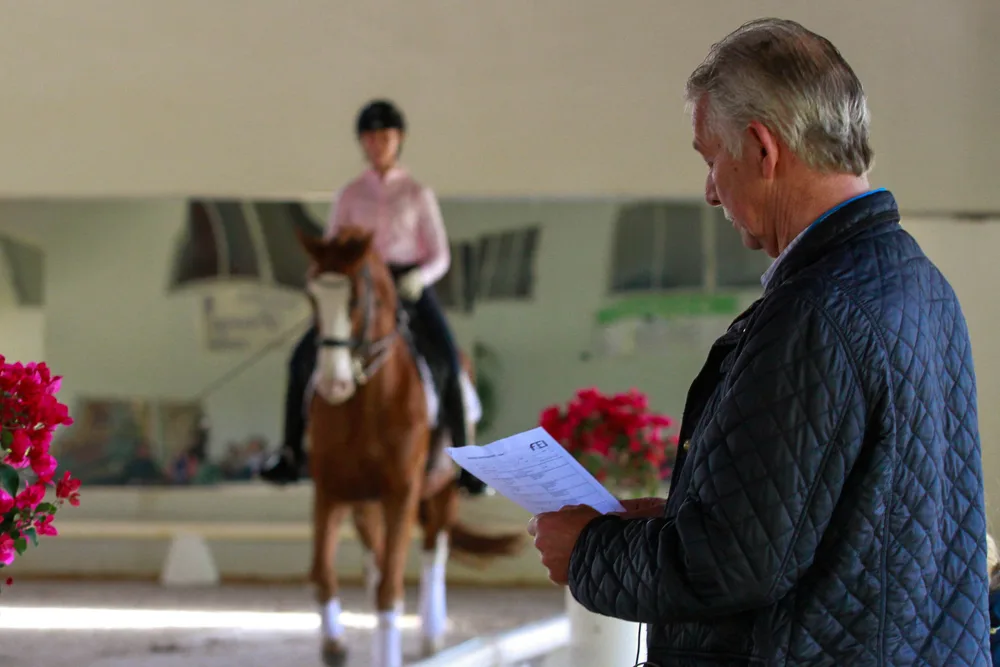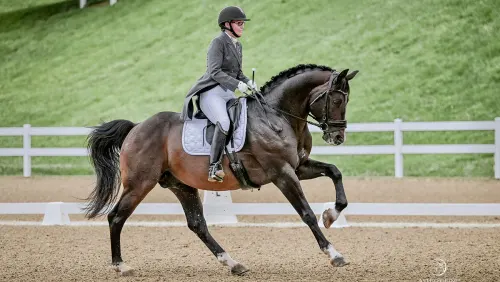Loxahatchee, Fla.—Jan. 19
The overriding theme the first day of the 2015 Succeed/USDF FEI-Level Trainers Conference was just that—that most of the eight participants overrode their horses.
FEI Dressage Judge General Stephen Clarke wittily doled out positive reinforcement alongside constructive criticism to the riders Monday at Mary Anne McPhail’s High Meadow Farm. Above all, Clarke wanted the horses to take responsibility for reacting to riders’ aids.
“When the horse starts reacting correctly, it will start to develop thoroughness,” he said.
The Golden Rule
The first rider, Annie Morris, was told to check, develop and increase her horse’s reaction time on Julia’s Magic, a 6-year-old Danish Warmblood gelding owned by Denise Sarnoff.
“Transitions, transitions, transitions are the name of the game,” Clarke said, explaining he wanted the horse to give an electric reaction to Morris’ aids in the walk/trot transitions.
“The horse’s job is to react,” he said. “The rider’s job is to sit and relax.”
Lisa Pierson rode the Intermediaire I test on Baryshnikov, a 14-year-old Hackney gelding owned by Leeda Fletcher, as Clarke gave running commentary from a judge’s point-of-view.
“Although it’s hard for riders to hear my nasty criticism, they need to think about the end score,” Clarke said. “What is it that I have to do to get those miserable points? Points make prizes!”
He told Pierson her biggest issue was Baryshnikov’s acceptance of the bridle. Clarke had her do walk/trot transitions to make sure the horse had brakes. Then, the trot/halt transitions tested the gelding’s stop time and reaction to her aids.
“Only 1,000 more and you’ll be there, but there is no compromise,” Clarke said. “He has to react honestly to the driving aid and the controlling aid.”
Then, Clarke recited what he called his Golden Rule: If a half-halt doesn’t work, then the next stride is a transition.
He tested the pair on a shoulder-in and told Pierson not to allow the gelding to compromise on the shoulder-in but, after it was correct, to let go of the inside rein while using her inside leg to keep the bend and movement, all while maintaining contact and control.
“It’s pointless without control,” he said.
Ridiculously Good Looking
Next, Clarke had 14-year-old Helen Claire McNulty focus on the horse’s reaction time after she rode the FEI Junior Individual Test on Reel Adventure, a 14-year-old Hanoverian gelding owned by Dr. Kristy Lund.
ADVERTISEMENT
McNulty and the gelding practiced transitions while Clarke told her to sit well, refuse to push and shove the horse, refuse to support him, and refuse to hold him together if he didn’t react off her leg.
“He works, you sit there,” Clarke said. “When you touch him, he must be ready to jump out of his skin.”
Clarke had her surprise the gelding by galloping forward every few strides so that she could be effective or quiet, as the need arose. He reminded her to reward the gelding only when she got the desired reaction and then the horse would take over the work.
When McNulty was reluctant to push the gelding forward, Clarke said, “Don’t leave him to start humming to himself! He thinks it’s enough to be good looking. Even good looking has to work.”
When Shelly Francis rode Patricia Stempel’s Danilo, a 10-year-old Hanoverian gelding, into the arena for the Grand Prix test, the pair wowed Clarke, who responded by awarding them a 10 for their classically produced piaffe.

Shelly Francis and Danilo demonstrated a classically produced piaffe.
Clarke asked Francis to perform less-than-ideal pirouettes by making them too large, the size of a “British roundhouse.” She grimaced, but complied.
“She wasn’t very good about demonstrating the bad one,” he said, adding that in order to get high marks, you have to meld quality with risk.
Then, he had her demonstrate an ideal pirouette as he pointed out how she started her pirouette on the centerline.
“The trick about the collection is the feeling of an invisible shoulder-fore before you begin,” he said.
Forward Not Sideways
After the lunch break, Clarke was blown away by the athleticism of D’Re Stergios’ horse, Sarumba, an 8-year-old Hanoverian mare. He had them work on technical details in lateral work, saying that the shoulder-in is the most important training tool and the preparation of almost every exercise. When Stergios and Sarumba performed a perfect shoulder-in, Clarke admitted that he was at a loss for words but managed to say “Good grief” several times during the ride.
He cautioned Stergios to make sure the shoulder-in did not require the use of the inside rein and that, once everything was in place, she should let the horse do the work.
“It’s just as important to be able to switch the horse off as switch the horse on, as far as energy and whiz, bang, pop are concerned,” he said.
The pair also worked on the first step of a half-pass by practicing the perfect set-up. They rode into a corner, did an invisible shoulder-in, and then proceed into the half-pass by leading with the shoulder.
“That’s how you produce a top-class half-pass,” he said. “It’s all about position and going forward. It’s not about going sideways.”
ADVERTISEMENT
Clarke said it was the first time he judged the Developing Prix St. Georges test after Jennifer Baumert rode Ramiro, an 8-year-old Dutch Warmblood gelding owned by Jennifer and Lisa Butterfield, down centerline.
“It’s not for idiots to ride, that’s for sure,” he said.
Baumert and Ramiro focused on the zig-zags and the horse’s anticipation of changes in hand. Clarke had her do a half-pass in trot to the quarter line, then a shoulder-in in the opposite direction while insisting the horse wait to proceed before allowing him to half-pass in the second direction. They worked on the exercise in canter with a flying change, where they half-passed, swapped the shoulder-in for a slight shoulder-fore, and executed a flying change to continue the half-pass with the bend in the direction of the shoulder-in.
“The flying change is the first stride of each new half-pass when it comes to the zig-zag in the Grand Prix,” Clarke said.
Tick Tock
Clarke had Christina Vinios work on reaction time and self-carriage after she and her 9-year-old Oldenburg mare Donna Carina 6 demonstrated the Prix St. Georges. They performed sharp transitions and varied the pace.
“Keep her alive,” he said. “Keep her thinking. Keep her reacting. Then you can balance her. Then you can activate her. Then you can leave her alone. The question is, ‘How much do you have to do to keep the transition moving forward?’ And the answer should be ‘Nothing.’”
Donna Carina has naturally rhythmic gaits and Clarke warned Vinios, “Don’t let her hypnotize you with her tick-tock.”
He also had her “play with the gears” in the pirouettes, suggesting she make sharp turns “like a bullfighter’s pirouette.” Then, he had her transition to gallop to get an immediate reaction.
“See, there are all kinds of things on offer,” he reminded her.
 |
| Noel Williams and Sir Velo focused on stepping into the contact while maintaining a steady rhythm. |
After Noel Williams rode the Grand Prix test on Sir Velo, an 8-year-old Westphalian gelding owned by Melissa Mulchahey, Clarke wanted Williams to alter the horse’s frame as well as his ground-covering ability.
Clarke had the pair walk in a circle and waited until the gelding stepped into the contact, explaining that the horse could not do that if his poll was too far down. Clarke asked Williams to make the horse spring forward.
Then, he told her he was going to make her do something she was going to hate. He had her gather all four reins in her left hand while slackening the curb bit. Her right hand was not allowed to go near her left hand. She told her to sit up, hold the contact with the left hand and then make Sir Velo trot while riding him forward into the contact.
Williams maintained contact until the gelding made a connection with her. Then, she stealthily took the reins in both hands and rode him forward into the contact with rhythm.
“He should go out on your terms,” Clarke said when he thought Williams gave away the reins. “He’s blackmailing you.”
Clarke promised the group that he would address the half-halt in depth Tuesday. ‘
“It’s a funny word,” he said of half-halt. “Collection is also a funny word. I don’t much like it. I rarely use the word ‘collection’ at lower levels. I use ‘actively engaged’ or ‘better balance.’”
The 2015 Succeed/USDF FEI-Level Trainers Conference continued on Tuesday to include Clarke’s promised discussion of humorous words; check in on Jan. 21 for a report on Day 2’s activities.















